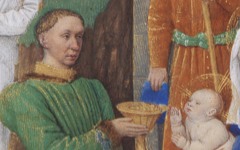Fouquet’s Portrait of King Charles VII (c.1450)
Jean Fouquet’s Portrait of Charles VII, King of France, is the earliest extant life-size independent portrait in Western painting. Although an historical icon in France, the sitter is not one of Nature’s more beautiful specimens. In 1938 Charles Sterling described it as “the unforgettable image of a spineless, weary man.”1 Such views, of course, are modern interpretations because the portrait was greeted positively by the royal Court at the time, as Erik Inglis noted.
Click next thumbnail to continue

L: Detail of Fouquet's Portrait of King Charles VII of France
R: Jean Hey, Man of Sorrows, Royal Museums, Brussels
Click image to enlarge.
He also pointed out that Charles’ portrait, posed behind a curtain, is based on images of Christ as the Man of Sorrows (right). This, he believes, establishes a parallel between what Christ suffered for humanity and what Charles suffered for France.2
Click next thumbnail to continue

L: Detail of Fouquest's Head of Christ (c.1470)
R: Detail of Fouquet's Self-portrait (c.1450)
Click image to enlarge.
It is telling that when Fouquet depicted Christ 20 years later (left), he based Christ's head on his own Self-portrait (right). Compare the eyes and lips especially. As I often explain, few recognize an artist's resemblance to paintings of Christ because it appears, from the general point-of-view, to be heretical. The idea, though, is perfectly in tune with Christian mysticism. [See Artist as Christ].
Click next thumbnail to continue

Fouquet, Head of Christ (c.1470) from The Book of Hours of Anne de Beaujeu, Lady of Baudricourt
Click image to enlarge.
Fouquet’s identification with Christ, thirty years before Dürer’s well-known Self-portrait as Christ, is strengthened by the position of Christ’s hands, the pre-emiment symbol of an artist, illusionistically perched as though on the frame itself.
Click next thumbnail to continue

L: Detail of Fouquet's Portrait of King Charles VII of France (c.1450)
R: Detail of Fouquet's Self-portrait, inverted (c.1450)
Click image to enlarge.
Thus Fouquet's underlying meaning is not that the King is Christ-like and has suffered for France but that Fouquet's soul, like that of other great masters, is king-like, Christ-like and pure. In this, one of the earliest manipulations of a king's features, Fouquet fused his own face into his monarch's using a precisely contemporaneous self-portrait. Perhaps that's why his own face is painted in gold, the color of alchemical purity.
More Works by Fouquet
Notes:
1. Erik Inglis, Jean Fouquet and the Invention of France (New Haven: Yale University Press) 2011, pp. 110-112
2. Inglis, ibid., p. 120
Original Publication Date on EPPH: 14 Jun 2014. | Updated: 0. © Simon Abrahams. Articles on this site are the copyright of Simon Abrahams. To use copyrighted material in print or other media for purposes beyond 'fair use', you must obtain permission from the copyright owner. Websites may link to this page without permission (please do) but may not reproduce the material on their own site without crediting Simon Abrahams and EPPH.


